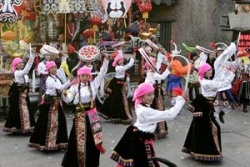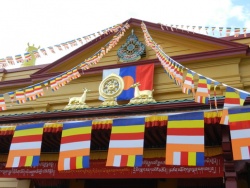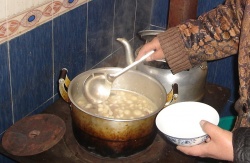What Is Losar?
The most important holiday in Tibet is Losar, which celebrates the Tibetan New Year. It's celebrated in February, but the exassct date varies each year according to the lunar calendar. Losar is a three day festival. On the first day celebrations are usually restricted to the family, with the second and third days being the time to visit and exchange gifts with friends and more distant relatives. mThis is also a time for Tibetans to visit monasteries and make offerings. Losar is marked with activities that symbolise purification, and welcoming in the new. Buildings are whitewashed and thoroughly cleaned, people wear new clothes and special food is prepared. Buddhist monks adorn the monasteries with the finest decorations, and conduct religious ceremonies. Rituals are performed to drive away evil spirits, and people celebrate with feasts and dancing.
The festival of Losar can be traced back to the pre-Buddhist period in Tibet. In the times when Tibetans practiced the Bon religion, every winter a festival was held where people offered large quantities of incense to please local spirits and deities. This festival eventually became the annual Buddhist festival we know today.
What Is Losar?
Losar is the name of the Tibetan New Year. In the Tibetan language, “Lo” means “Year” and “Sar” means “New”. The Losar festival pre-dates Buddhism in Tibet and goes back to the time when the Bon religion held sway in that country. In those days, incense was burned every winter in purification rituals used to placate the gods. As irrigation, cultivation, and refinement techniques were introduced, Losar ceremonies became more celebratory, as a gesture of thanks to the gods for the budding innovations. Eventually with the advent of rudimentary astrology, Losar became more than a farmer’s festival, finally mutating into a Buddhist festival, celebrating the New Year.
When and Where Is Losar Celebrated?
Tibetan New Year festivities take place in January or February. Tibetan Buddhists follow the lunar calendar so the date of Losar is different each year. While Losar celebrations once lasted for as long as two weeks, in modern times, Losar is normally a three-day festival. Losar is celebrated by Buddhists in Tibet, India, Bhutan, Sikkim and in Tibetan expatriate communities throughout the world.
How Is Losar Celebrated?
In the days leading up to the Tibetan New Year, as part of the purification required for the new year, new clothes are made or purchased, houses are cleaned and decorated and new Buddhist prayer flags are raised.
People usually spend the first day of Losar with members of their immediate family. They wear their new garments and eat celebratory foods such as guthuk noodles, made from cereals and dried cheese, and various types of vegetable soups. They often drink Changkol, a type of rice wine similar to Japanese sake.
Dough balls containing small hidden items, such as chilies or coal may be served to guests. Whatever you find inside your dough balls is supposed to be a light-hearted reflection of your character. A white article such as rice or salt found in your dough ball indicates that you’re going to be lucky in the forthcoming year; a black article such as a small piece of coal suggests the opposite.
On the second and third days of Losar, people visit friends and other family members who don’t live close by. They may also pay a visit to their local Buddhist temple, monastery or shrine and make offerings as part of the purification rituals for Losar.
Buddhist Monastery Losar Festivities
Losar is an important time for Buddhist monks. The monks spring-clean their monasteries and put up special decorations. They recite prayers and perform rituals to dissolve negativities of the old year and purify the new year. Monks also make a point of wishing good luck for the forthcoming year to the Dalai Lama.
Naming A New Year:
At first sight, the naming of each Tibetan New Year appears to be a little complicated. However, the process is quite logical when you understand the naming rules. • Tibetan New Year is identified by an Animal: Hare, Dragon, Snake, Horse, Sheep, Ape, Bird, Dog, Pig, Mouse, Bull, Tiger • In addition, each year is identified by an Element: Fire, Earth, Iron, Water, Wood • Finally, the gender alternates every other year: For example, the Tibetan year that started in February 2005 is the Female Wood Bird year. This will be followed by the Male Fire Dog year, then the Female Earth Pig year, and so on, in a sixty-year cycle.
This year marks 2,850th celebration of Sonam Losar. The meaning of Losar is New Year in the languages of Tibeto-Burmese origins. Lo means year, and Sar means new. ‘Lo-Chhar’ in Tamang also means the same thing. This festival evolved in Tibet and China; the Chinese also celebrate their traditional New Year on this day. They follow a lunar calendar, along with the Buddhist and Bon people in the Himalayan regions of northern Nepal. But some mark Sonam Losar as their New Year, whereas many, including Sherpas and Bhotes, mark Gyalbo Losar.
The meaning of Sonam (swenam) is blessing. In Losar blessings for good fortune are sought by farmers, professionals, and all members of society. Gyalbo means ‘King’. Some say that Gyalbo Losar was created by a Tibetan king in order to distinguish between New Year celebrations for citizens and government officials. Although there is a one month gap between the two Losars, every 12 years they occur at the same time.
The meaning of Sonam and Gyalbo Losars is thus interpreted through Tibetan myths, which may not match our ancestral practices. Also, our celebrations cannot arbitrarily copy those of other communities. They have to be consistent with our history and culture and respect our ancestors’ contributions.
After the promulgation of the 1990 constitution, there were various ethnic movements in Nepal. As a result, Sonam Losar was introduced as the New Year of Tamangs. Before that, many Tamangs celebrated Gyalbo Losar and Maghe Sankranti as their New Year. Many continue to do so today. It would be good if all Tamangs celebrated a single Losar. We cannot create a new culture in the name of identity.
This year is the year of the horse. Some Tamangs are spelling it ‘Taa-Lo’, which is wrong. The word ‘Taa’ means ‘Tiger’, whereas the correct word is ‘Tabu-Lo’, where Tabu means horse. One has to be conversant in Sambota scriptures, or Tibetan languages, or at least Tibeto-Tamang or traditional Tamang language to understand concepts related to Losar.
The author is an advocate phurpatamang10@gmail.com


